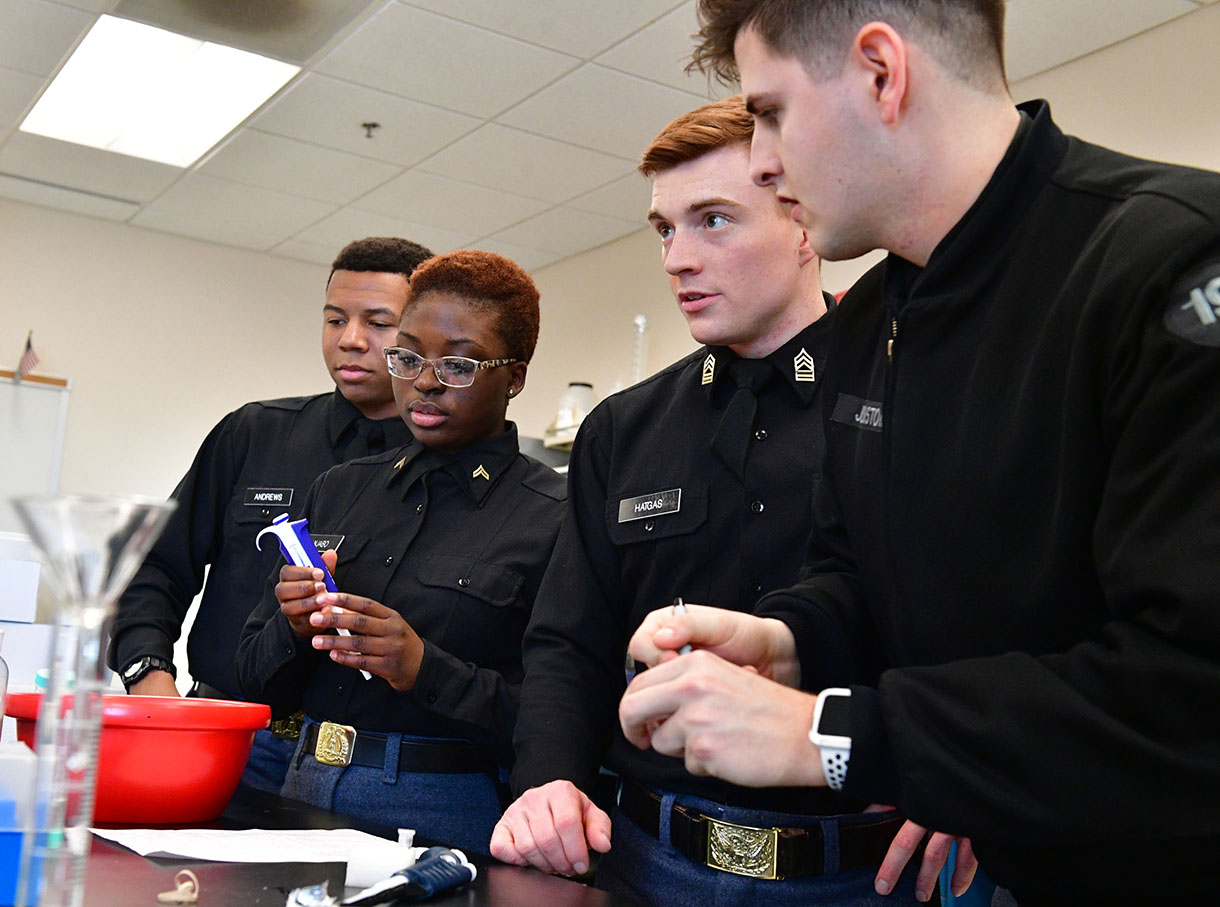Stories
Reptile Fungus Offers Opportunity for Cadet Study

Cadets (from left) Tavis Andrews ’20, Holly Njabo ’20, John Hatgas ’19, and Corey Johnstone ’19 ready their DNA samples for analysis.
Lt. Col. Emily Lilly knows how to take lemons and make lemonade. Confronted by the yellow fungus, a fatal disease affecting lizards coming into her Blue Ridge Reptile Rescue, she’s taking steps to both solve the problem and create learning opportunities for cadets.
Lilly, associate professor of biology, has four cadets conducting an independent study in molecular biology with her this spring. The four—Tavis Andrews ’20, Corey Johnstone ’19, John Hatgas ’19, and Holly Njabo ’20—are charged with extracting fungal DNA from lizards who have been euthanized due to yellow fungus and then performing a polymerase chain reaction (PCR) analysis to determine what species of the fungus infected the lizard in question.
Long interested in reptiles, Lilly explained that yellow fungus currently only affects lizards kept as pets, but since unwise pet owners sometimes release their pets into the wild, there is a high potential for the disease to spread to wild populations.
“The variety of taxa it can affect is very, very broad,” said Lilly. “That indicates it could leap to our native lizards. … There’s the potential for this to pose an ecological threat.”
At her Fairfield home, where she runs her rescue operation for unwanted reptiles, Lilly often encounters mystified pet owners who tell her that their lizards used to be good-natured but are now snappish and don’t want to be handled. One glance at rotting flesh and necrotic extremities are usually all it takes for Lilly to make the diagnosis. If the disease is advanced to a certain point, ending the animal’s suffering through euthanasia is the only option.
“As a biologist, I’m looking at this and thinking, ‘This should be treatable,’” said Lilly.
But to treat the disease, it’s essential to know as much as possible about it. Lilly explained that no one knows if there is a separate species of fungus affecting different species of lizards or if all lizards are susceptible to the same strain of fungus.
That’s where the cadets come in. “We’re trying to figure out where this [fungus] falls in the taxonomic hierarchy,” said Johnstone. He explained that he signed up for the independent study because either graduate school or medical school might be in his future down the road.
“A lot of these skills look really good on an application,” he said. “And if all else fails, I have a chance to work in a lab somewhere.”
The independent study format also gives cadets a chance to hone their lab techniques in a way that regular classes cannot.
“I actually get to come into the lab on my own time, and I get to go more in-depth,” said Andrews, who took a genetics class with Lilly last fall. “With the genetics class, because of the course load, if you fail [at a lab technique], you have to move on. But with [Lt.] Col. Lilly, I have enough time that if I fail, I get to come back and do it again and again.”
Lilly echoed this, saying, “In a typical class, like in genetics, we’ll run the PCR lab once, and then we have to move on to something else, whether or not each student was successful. In this independent study, each student will be successful.”
Andrews said he enjoys having a project with real-world applicability, plus the chance to practice lab skills. “You’re not just doing something because it’s an assignment. … I know the purpose of each step, which really helps my learning,” he noted.
“You’ve got to go out of your way to learn,” said Njabo, who plans to take the Medical College Admissions Test this summer. She admitted to being frustrated sometimes, especially when she’s spent the better part of an hour trying to extract DNA and only got water, but she feels the independent study is worth her while. “The more times you run [a DNA extraction], the better results you get,” she commented. “Everybody should try [an independent study] at least once.”
- By Mary Price
.svg)
.png)

